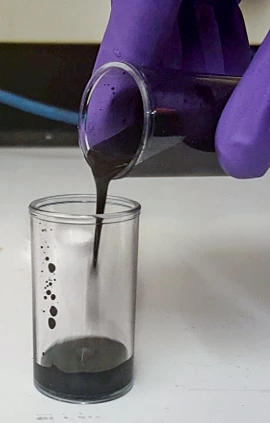Devices known as flow batteries attract a lot of attention from scientists looking for affordable solutions for grid-scale energy storage, but are they affordable enough? A team at MIT believes there is room for improvement on this front, and has developed a novel electrode material likened to soft-serve ice cream that they believe can be integrated into a "semi-solid" battery to store renewable energy on the cheap.
Flow batteries are a particularly enticing proposition when it comes to storage of renewable energy, as they are flexible, scalable, and far cheaper than lithium-ion. These devices store their energy in a liquid held in two tanks, collecting or releasing it as the liquids pass ions through a special membrane that turns chemical energy into electricity.
Because the storage capacity of the system can be scaled up simply by increasing the size of the tanks and therefore the amount of liquid electrolyte they can hold, flow batteries may offer a way to store vast amounts of renewable energy at relatively low cost. Also working in their favor is that they can store this energy for potentially months at a time, filling inevitable gaps in the intermittent supply offered by solar and wind.
The MIT researchers set out to design and build a more affordable form of flow battery that uses cheaper chemicals than current candidates, such as redox flow batteries that rely on vanadium. The team carried out extensive experiments in the lab in a search of a more affordable electrical conductor, finally landing on a recipe for a sludgy mixture with a consistency likened to molasses that seems to offer the desirable properties.

The winning formula, with a texture similar to soft-serve ice cream, is made of a thick black mixture containing dispersed manganese dioxide (MnO2) particles with an electrically conductive additive in carbon black. When the mixture is pumped from the tanks toward the membrane, the carbon black reacts with a conductive zinc solution to efficiently convert chemical energy into electricity.
A semi-solid flow battery featuring this mixture was put to the test alongside other energy storage systems, with the team looking to see how they compared in terms of operational costs. Because it uses a slurry-like mixture in place of the watery solutions featured in conventional flow batteries, it does require more power to pump it from the tank to the membrane. But even accounting for this, the scientists say their novel semi-solid flow battery performed well.
They calculated the capital costs of running it across eight-, 24- and 72-hour durations, and found that for any storage lasting longer than a day the design came up trumps against a vanadium redox flow battery and a lithium-ion battery.
“We performed a comprehensive, bottom-up analysis to understand how the battery’s composition affects performance and cost, looking at all the trade-offs,” says study author Thaneer Malai Narayanan. “We showed that our system can be cheaper than others, and can be scaled up.”
The scientists note that a patchwork of storage technologies will be required to facilitate a wholesale shift to renewable energy. Different scenarios might call for different solutions, with lithium offering a good backup option for periods of eight hours or less but expensive for any longer than that, and while hydrogen is expensive for short-term storage it can be cost-effective for long durations, according to the team. The team plans to continue developing the novel battery system to see where it might sit in this lineup.
“The transition to clean energy requires energy storage systems of different durations for when the sun isn’t shining and the wind isn’t blowing,” says Emre Gençer, a research scientist with the MIT Energy Initiative and a member of the team. “Our work demonstrates that a semisolid flow battery could be a lifesaving as well as economical option when these VRE sources can’t generate power for a day or longer – in the case of natural disasters, for instance.”
The research was published in the journal Joule.
Source: MIT




